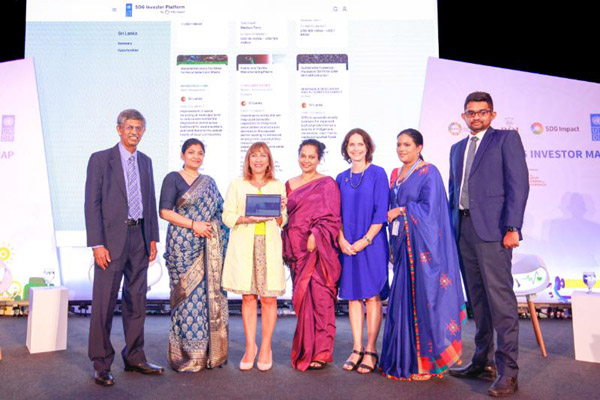
Above - At the launch:From left - Manjula De Silva, CEO, Ceylon Chamber of Commerce (CCC); Ms. Renuka Weerakone, Director General, Board of Investments (BOI); Ms. Hanaa Singer, Resident Coordinator, United Nations in Sri Lanka; Ms. Chamindry Saparamadu, Director General, Sustainable Development Council in Sri Lanka; Ms. Malin Herwig, Officer-in-Charge, United Nations Development Programme (UNDP) in Sri Lanka; Ms. Dulani Sirisena, SDG Integration Specialist, UNDP in Sri Lanka; and Shiran Fernando, Chief Economist, Ceylon Chamber of Commerce (CCC).
The Government of Sri Lanka and UNDP in Sri Lanka recently launched the Sri Lanka SDG Investor Map (the Map), a market intelligence tool that seeks to direct private capital where Sri Lanka’s Sustainable Development Goals (SDG) priorities, Government policy and market opportunity intersect, as the country seeks to rebuild its economy sustainably, using the SDG framework as its guide. The methodology for the map was created by UNDP SDG Impact, according to a UNDP media release.
Like many other countries, the Sri Lankan economy was also impacted by the COVID-19 pandemic with GDP growth contracting 3.6% in 2020 with a significant slowdown in tourism earnings which is a key source of dollar income for the country. Sri Lanka is building pathways to recover from its double crisis of sovereign debt and a balance of payment crisis, making it difficult to import essential items such as medicines, fuel and food. The current public debt is 140% of GDP and Sri Lanka’s plan is bring it down to less than 100% by 2032.
The release said that while Sri Lanka is pursuing an IMF program to stabilise its macro-economy and restructure its external debt, private capital, foreign direct investments, blended finance options and public-private partnerships, are all needed. The SDG Investor Map will be of importance when channeling these funds to investments for social and environmental objectives- towards green development, women’s economic empowerment, social sector development (example: health).
The map will be a crucial tool to accelerate Sri Lanka’s recovery pathway and build forward better. The map can be used by:
In Sri Lanka, the map was the result of a strong collaboration between UNDP and Sri Lanka’s Sustainable Development Council, the nodal government institution responsible for coordination, facilitation, monitoring, evaluation and reporting on the implementation of the 2030 Agenda for Sustainable Development in Sri Lanka. Sri Lanka's apex investment promotion agency, the Board of Investments (BOI) of Sri Lanka, also provided input and validation during the development of the map and is a key partner for the map's launch. Through secondary research and over 50 consultations with public and private sector organisations, the map has identified 15 Investment Opportunity Areas (IOAs) that cover investment themes and business models across 5 SDG priority sectors: Renewable Energy, Healthcare, Infrastructure, Food & Beverages and Consumer Goods.
At the event, UNDP called on the private sector to adopt the SDG Impact Standards, the independent and global management standards that guide businesses and investors in their decisions to optimize interrelated economic, social and environmental impacts. The forthcoming SDG Impact Standards Assurance Framework and SDG Impact Seal recognizes investors and enterprises who are more likely to be contributing positively to sustainability, reducing the risk of impact-washing.
Leave Comments